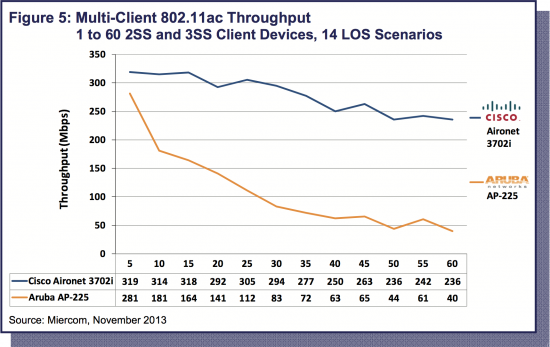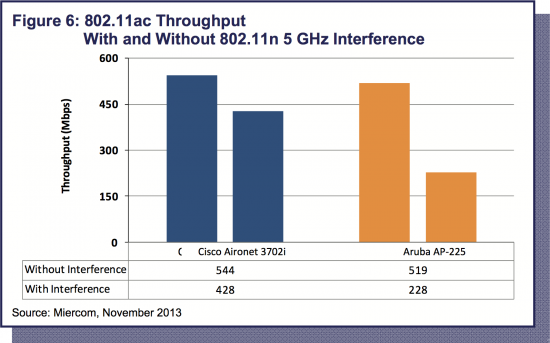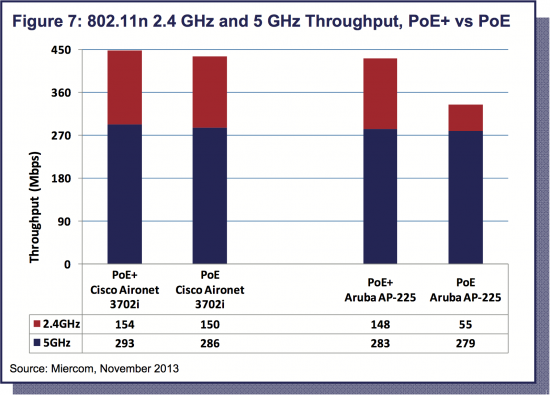Cisco’s newest 802.11ac product, the Aironet 3700 Series Access Point is now orderable and shipping in the next few weeks. The AP 3700 features an integrated 11ac radio with a 4×4 architecture and Cisco’s High-Density Experience (HDX) Technology. HDX is a suite of features specific to the AP 3700 that delivers the best possible user experience, especially in high client density networks. HDX is enabled by a combination of hardware and software features on the AP 3700, features including:
- CleanAir 80 MHz – Interference detection and mitigation
- ClientLink 3.0 – RF link quality
- Smart Roam – Intelligent roaming handoff
- Turbo Performance – Performance with high client density
Aruba recently launched their 802.11ac access point, the AP-220 series, featuring a 3×3 design.
Miercom recently published a third-party evaluation of the performance between the AP 3702i and the AP-225. The report consists of a diverse range of test cases meant to gauge real-world performance of the access points. The tests include; multi-client performance, single client rate vs. range, performance in the presence of interference, and performance on reduced power. Here are some of the highlights from the report.
Multi-Client Performance
The AP 3700 performed very well in the multi-client performance test, thanks impart to HDX Turbo Performance. With 60 clients, the AP 3702i had a 6x performance advantage over the AP-225. The AP-225 struggled to serve all the clients and only mustered 40 Mbps total. The AP 3702i was able to transmit a healthy 236 Mbps, while maintaining fair throughput to each client.
The test consisted of 60 11ac clients, all associated to the 5 GHz radio. The clients used were 10 Dell E6430 laptops with Broadcom 4360 three spatial-stream chips, 20 Apple Macbook Air two spatial-stream laptops, and 30 Dell E6430 laptops with Intel 7260 two spatial-stream chips. Clients were setup in an open office environment surrounding the AP. Distances varied from 10’ to 50’.

The AP 3702i remained relatively consistent, only dropping 80 Mbps while scaling from five clients to 60 clients. The Aruba AP had a big drop from five clients to 10 clients, and kept falling thereafter.
Rate vs. Range
Rate vs. Range was a mainstay of Wi-Fi testing in a time when wireless networks were designed for maximum coverage instead of coverage and capacity. The preferred test to emulate real-world conditions is multi-client performance, but rate at range testing can be useful to showcase RF-excellence.
The rate vs. range tests highlighted the advantage of ClientLink 3.0. In addition to the standards-based beamforming, the AP 3700 is able to use ClientLink 3.0 coupled with the 4×4 architecture, to beamform to 802.11a//g/n/ac clients. The advantage of this architecture is obvious from looking at the results of the tests.
Here are the results from a one spatial-stream client, typical of a smartphone. The client used was a Samsung Galaxy S4

The two spatial-stream results. An Apple MacBook Air was used.

Finally, the three spatial-stream results. This was a Dell E6430 laptop with a Broadcom 4360 chip.

There were two test locations at each distance. Locations from 10’ to 75’ were in a cubicle office environment. Locations at 100’ and 150’ were in separate rooms from the access point.
Interference
Wi-Fi and non Wi-Fi interference has been the bane of 802.11g networks for years. The answer for most, has been to move to 5 GHz. Well, 5 GHz is about to get a heck of a lot more crowded thanks to 11ac being a 5 GHz only technology. Whereas with 2.4 GHz, the leading cause of interference was likely non Wi-Fi, in 5 GHz, thanks to the density in which wireless networks are being deployed, Wi-Fi is the leading cause of interference. That is, interference caused by other on-channel access points. Using dynamic frequency selection (DFS) channels will help to minimize the likelihood of co-channel interference and so will using narrower channel bandwidth in high-density scenarios, as well as proper RF design.
With the advent of 80 MHz wide channels, the likelihood of co-channel interference on some part of that 80 MHz is entirely plausible. The interference test shows what happens to performance when another access point is setup on-channel to cause Wi-Fi interference. The test was to run traffic to a single MacBook Air client. Then, setup an interfering access point (I-AP) on the secondary 40 MHz channel of the AP under test (APUT) such that the AP under test hears the interfering access point at -80 dBm. Associate a client to the I-AP. While traffic is running to the client on the I-AP, run traffic to the original MacBook Air on the APUT. Compare the throughput from before the interference, to after the interference.
This map illustrates the test setup:

Here are the results. The throughput on the AP 3702i dropped by 25%. The AP-225 dropped by 125%. The AP 3700 is much more tolerant of interference thanks to the capabilities of CleanAir 80MHz which is built into the Wi-Fi chipset on the AP 3700.

Performance on Reduced Power
802.11ac access points require more power for full functionality than 802.11n access points. The 11ac AP’s out there draw slightly more than 802.3af (PoE) power. So, what happens if your switching infrastructure only supports PoE, but you still want to deploy 11ac? The performance of the access point is usually restricted in someway. With the AP 3700, the impact is minimal. A transmitter and a receiver are turned off on each band. That takes the AP 3700 from 4×4:3, down to the same level as the other 11ac access points out there. A 3×3:3. All other functionality remains enabled.
Aruba cripples 2.4 GHz on the AP-225, dropping to a single spatial-stream, as well as disabling the second Ethernet port and the USB port.
The test case was to power the AP with full 802.3at PoE+ and associate one client to the 2.4 GHz radio and one client to the 5 GHz radio. Run traffic to both clients, and then run the same test, but with the AP powered with 802.3af PoE. Two MacBook Pro clients were used.
The AP 3700 performance drops less than 3% when on PoE. The Aruba AP-225 performance drops almost 30% when powered on PoE.

For more information on how the tests were carried out, or the tools used, please consult the full report from Miercom.
To learn more about the AP3700, visit the product page or check out the Cisco 802.11ac solution hub.


Great detailed report.
What was the client mix ratio for the sub-60 client scenarios?
Great write up! I can not wait to get one of these for my companies Lab!